Want to learn about a homeschool loop schedule? You’re in the right place.
So let’s set the stage. Let me know if this sounds about right to you.
You know how it is. At the beginning of the year, you’re super ambitious and make all these plans to learn all. the. things. And it’s great for a couple weeks.
But after a bit, you realize that all the things take all the time to complete. Now you’re overextended and exhausted.
Do you push through and keep doing everything, wearing yourself and your kids out each day? Do you break some things down and only do certain things on certain days?
I suggest you find a middle ground and create a loop schedule! A loop schedule will help you get through more things more often. And it keeps everything in a manageable, flexible structure so you won’t feel tied down.
If the idea of a flexible loop schedule for homeschool sounds great to you, keep reading! Be sure to check out the free printable below!

What does loop mean in homeschooling?
A homeschool loop schedule is a flexible list of items or subjects you would like to complete in your homeschool. But rather than completing the list each day, you will complete what you can in one day. Then the next day you will pick up in the list where you left off. When you finish the list, you will loop back around to the top of the list. This is what makes the list a loop.
Loop schedules in homeschooling are a flexible way to ensure you get to the subjects and topics you want to often, without feeling boxed into a schedule.
This isn’t about doing less or more in a day. It’s about a tool to help when you get overwhelmed and can’t get to it all. You will no longer miss or leave off important subjects because they are at the bottom of the list!
Let’s be honest. You just can’t get to it all! Plus, appointments come up, someone gets sick, everyone gets cranky, and math produces tears. Some days, you just need to call it a day before you’re “done”.

How to do loop scheduling in homeschool
When creating a loop schedule for your homeschool, first list the things you want to do in your homeschool day. This is your basic loop. On day 1, you will start at the top of the list and work your way down until your homeschool time is up. Then mark where you left off, because the next day, you will start there! When you get to the bottom of the list, you will loop back to the top and start again.
Here’s an example.
Say you have five things on your group learning list to do each day.
- Manners
- Poetry
- History reading
- Science reading
- Novel
Here’s how 5 days of group learning time might look with a loop list:
Day 1
- Manners
- Poetry
- History Reading
- Science Reading
- Novel
Day 2
- Manners
- Poetry
- History Reading
Day 3
- Science Reading
- Novel
- Manners
- Poetry
Day 4
- History Reading
- Science reading
- Novel
- Manners
- Poetry
Day 5
- History Reading
- Science reading
- Novel
- Manners
Of course, you could do each of the 5 things each day of the week. And that’s a good goal. In the example above, most subjects were done only 4 times in 5 days, but what often matters most is consistency! Something is always better than nothing.
And what if you had an appointment one day and didn’t get to the bottom of the list? Do you start the next day from the top and skip the items at the end of the list?
This is where the loop list is helpful. You would simply start the next day where you left off, then finish the list and loop back to the top, working your way back down the list as time allows.
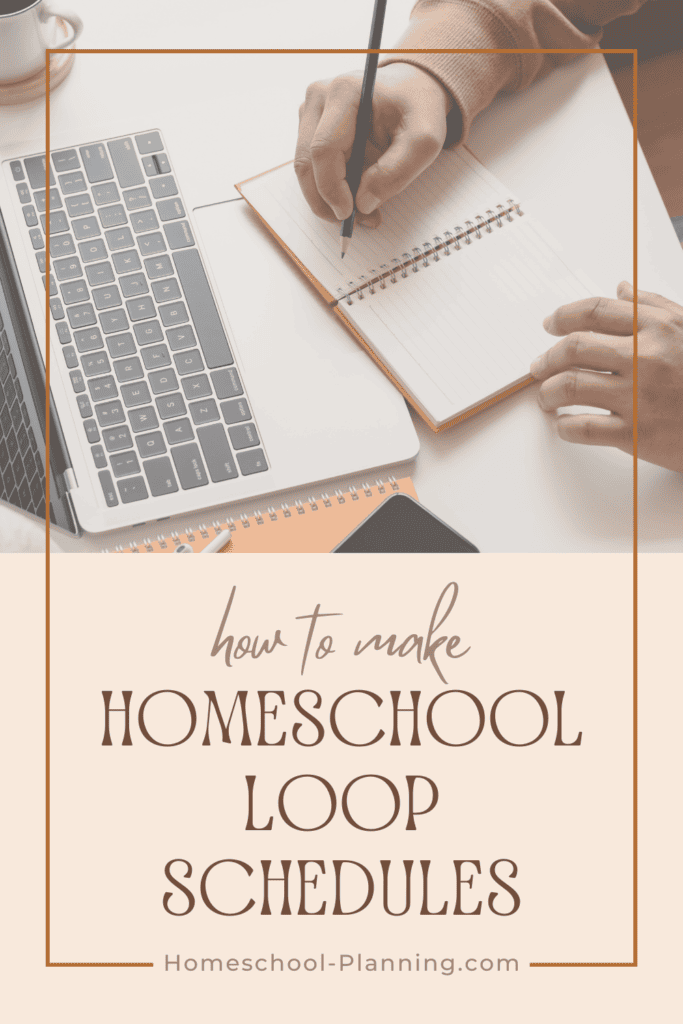
Why is a loop schedule helpful?
A loop schedule is a flexible and easy way to schedule your homeschool routines. It removes the stress of trying to get to everything while still ensuring you get to most things fairly often. It’s a great way to add some flexibility to your homeschool days!
To understand more about how a loop schedule may help you, let’s look at what things may look like without it.
To me, I see many people using a couple main approaches to scheduling their homeschool subjects:
Option 1: Do everything every day
Doing every subject every day will wear you out and get a little monotonous. Especially if you have a lot of things you want to do with your kids. It’s easy to start feeling overstretched and behind.
Option 2: Assign certain subjects to certain days
As a way to reduce what you do each day, you may decide to do certain subjects on certain days, like science on Mondays, Wednesdays, and Fridays. Then history on Tuesdays and Thursdays. Once again, this is often a great approach for scheduling your weekly subjects.
But what happens if you have an appointment the next three Tuesdays and you can’t get to history? Do you just skip half of your history for 3 weeks?
Option 3: Loop schedule to the rescue
If you are looking for an alternative way to schedule homeschool subjects in your week, then a loop schedule may be a good fit for you. Rather than doing everything every day, or assigning certain subjects to certain days, take the stress off your shoulders and do what you can do easily each day. Then simply pick up where you left off the next day.
A loop schedule is as simple as that!
If you get to it all some days, then fabulous. If not, no pressure. It will still be there tomorrow. A loop schedule is a simple and flexible way to get to it all as often as you’d like without being tied to a strict schedule you can’t keep.
Sometimes, all that’s needed is a reminder that our lives don’t have to be run by our homeschool. Remember to put a little more home in your homeschool. Keep it simple, flexible, and comfy.
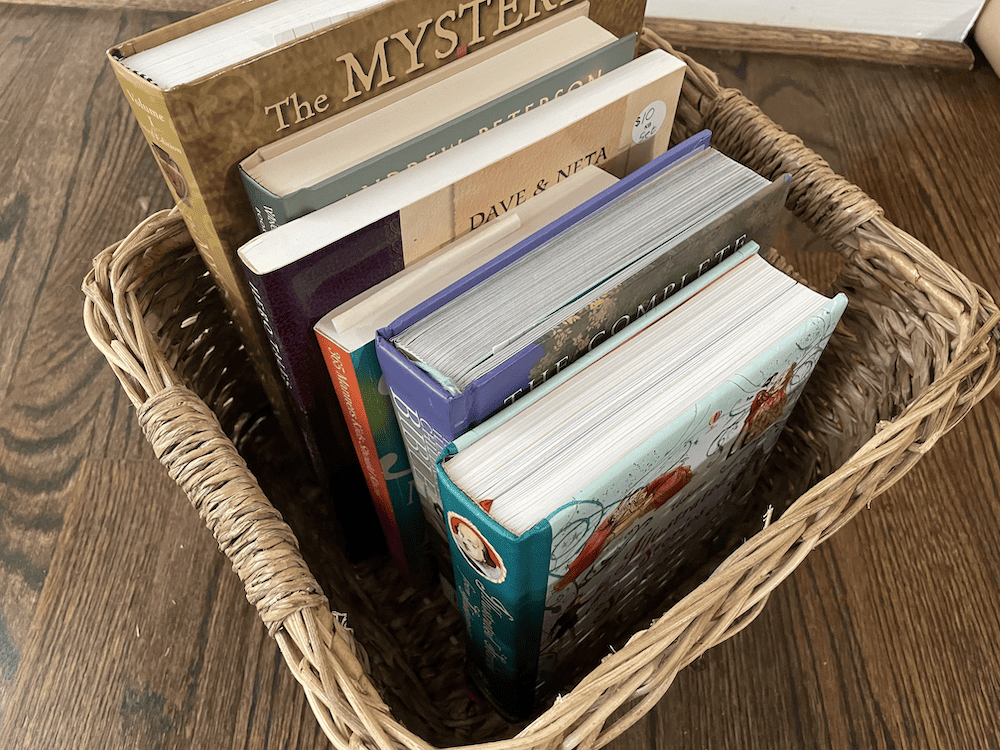
Keep it simple with a basket
As with most things, looping lists can get overcomplicated quite fast. So before we get any farther, I want to encourage you to keep it simple with the help of a basket!
If you are using several different books in your loop, keep those books in a basket. Pick up the top book to use first. As you use the books, you will place them at the back of the pile in the basket. This will keep your books in the order you will use them.
You won’t need to remember what you did last or keep a paper list to continually check off. All that makes loops way too complicated. And this is supposed to be something that simplifies your life!
So keep your looping basket ready to go and it will be so much easier!
When might I use a loop schedule in homeschool?
There is no limit to the uses of a loop schedule in your life and homeschool. Here are a few ideas:
- Daily core subjects
- “Extra” subjects
- Daily/weekly chores
- One-on-one time with your kids
- Great for Charlotte Mason homeschoolers
- Group learning time (Morning Time, Morning Basket)

Variations of homeschool loop schedules
The most basic homeschool loop schedule is to make one list, looping through it each day. But there are so many more ways to use the idea of a loop schedule in your homeschool! Here are several more.
Loop in a list
Even looping lists can get a little stuffy. So you may find you’d rather loop only some of the subjects each day instead of them all. You may have some things you would prefer to do each day. For this, you can create a loop in a list.
Just like it sounds, you will have a daily list of items you want to accomplish. In that list, is a looping list.
For instance, you may want to be sure to do math and writing every day. But you want to loop science, history, and reading. Your list may look like this:
- Math
- Writing
- Loop:
- Science
- History
- Reading
So each day, you will do math and writing. Then as much of the loop as you can. Perhaps it will be science and history one day. Then reading and science the next. Then just history the day after that.
You see how it works? Looping doesn’t have to be done with every subject. Use it in the way that works for you.
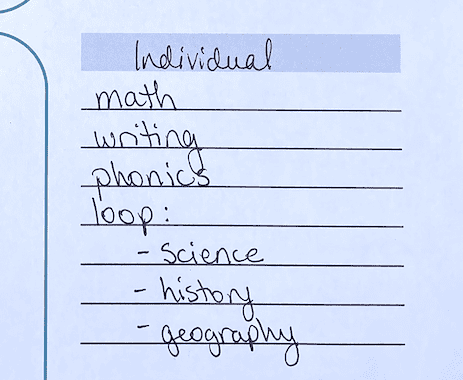
One loop item each day
To create another spin on the loop schedule, let’s see how it would be if we used our daily list with a loop list inside, just like the last section. But this time, rather than looping through as much as possible each day, we just do one item from our loop list each day.
This is how that would work with the same subjects:
Day one
- Math
- Writing
- Science
Day two
- Math
- Writing
- History
Day three
- Math
- Writing
- Reading
Day 4
- Math
- Writing
- Science
Pretty simple, huh? There’s no shortage to the looping fun!
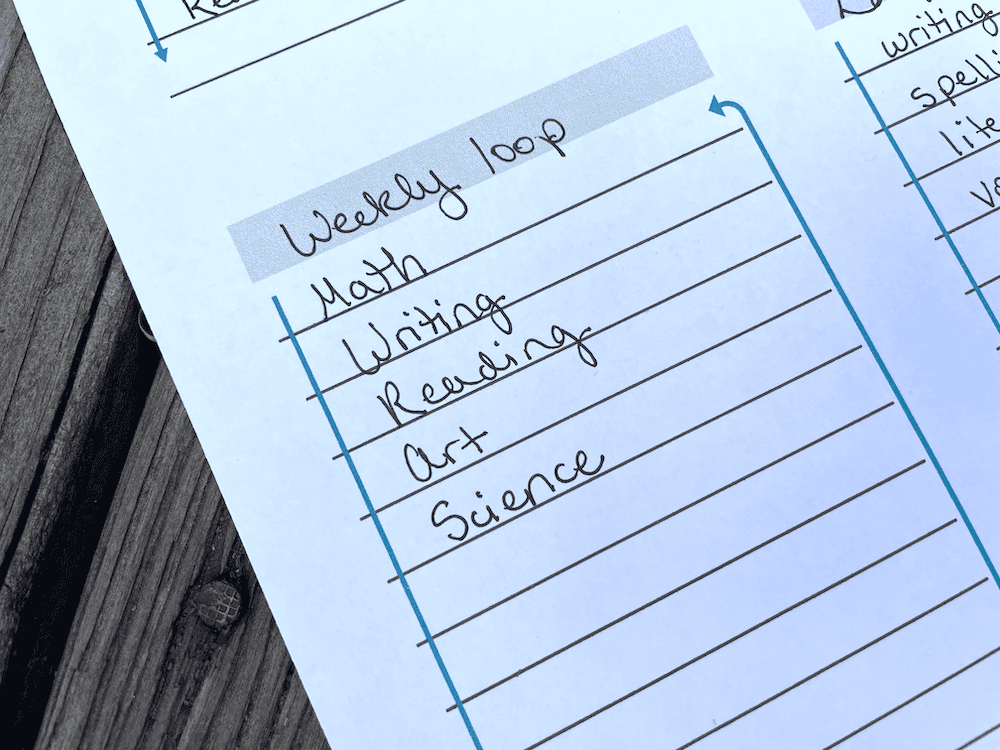
Loop your week
Perhaps you’re really loving this loop thing and want to put your whole school week on a loop, rather than just each day. Maybe you really like to block your time into larger chunks, so doing just 1-2 subjects each day is still your thing. You can still use a loop schedule!
Just simply put each thing you want to do each week in a list. Then loop through them. Then you won’t have to worry about missing a day and feeling behind. Or if you have a short day in one subject, you can keep going if you’d like!

Add some multiple times
If you want to loop your whole week but want to continue doing shorter lessons most days for most subjects, feel free to add everything to your list the same amount of times you’d like to do the subject.
For instance, you want to do your weekly subjects like this:
- Math 5x a week
- Writing 4x a week
- Science 3x a week
- History 2x a week
- Reading 3x a week
- Art 1x a week
- Music 1x a week
How in the world could you schedule this easily? Looks like it would get confusing real quick!
But if I created one long homeschool loop list with all these things, generally in the order they would happen in a perfect week, then we would have a great loop list! No more feeling stressed for missing a day, no need to create a messy schedule. And you can see your whole week at once!
Here’s what that list might look like:
- Math
- Writing
- Science
- History
- Reading
- Math
- Writing
- Science
- History
- Reading
- Math
- Writing
- Science
- Reading
- Math
- Writing
- Music
- Math
- Art
The extra great thing about this is that if you have an easy lesson in one subject one day and want to do a little extra, you can do that too! Nothing says loop schedules are only helpful if missing days. You can even get things done a little early!

Loop your kids
Using a homeschool loop schedule can also be helpful if you have multiple kids. With so much going on in your homeschool day, you may not always be able to fit in the one-on-one time you’d prefer each day with each of your kids.
So you could use a loop schedule to make sure your time is dispersed between your kids. Big families need things like this to stay functional, cause there is only so much of mom’s time to go around. And constant chaos of questions from everyone at once can be frustrating.
Rather than sectioning off your whole day in 10-minute increments so you can get to each child, you could spend 30 minutes with each child, rotating through only a few kids each day. Yes, this may mean you don’t work with every child directly every day, but older kids won’t need as much attention so it should work fine. And you could be sure to make time each day to help your littles with their work.
Or maybe you’d like to do something extra with each of your kids once a week in your school day. This year I had special books I wanted to read with each of my 3 kids on their own.
So after our group learning time each day, I took a few minutes to read one-on-one. But I rotated through the kids, one each day. This allowed us to do that special thing together without taking as much of our time from other things.

Loop for one subject
So far, we’ve mostly talked about using a homeschool loop schedule for getting through multiple subjects in your day or week. But what if you have several resources you want to use for just one subject?
Like for language arts you want to do writing, spelling, vocabulary, phonics, literature, and grammar. Wow that’s a lot! Do you need to do it all, every day of the week? I’d say not! Instead, put it all into a loop for your week!
And if you want to do writing, literature, and spelling more often than the others, adjust your loop list to accomodate that. Your language arts loop may look something like this:
- Writing
- Spelling
- Literature
- Vocabulary
- Writing
- Spelling
- Phonics
- Writing
- Spelling
- Literature
- Grammar
For another more simple example, you want to do music with your kids. In music, you want to learn about composers, basic music theory, and learn about various instruments. But you don’t want to take up more than 15 minutes in your group learning time.
In comes a loop list!
With this one, you could just create a basic loop list that you loop through, doing however much you can get through in 15 minutes. Probably just one thing a day. That’s plenty!

Loops in a loop
Now if you really want to get fancy with your homeschool loop schedule, then here’s the thing for you! Who knew there were so many ways you could use a loop in your homeschool?
Say you want to do so much in your homeschool, there just isn’t an easy way to organize it….or is there? Maybe a homeschool loop schedule will work!
If you’re someone who pieces things together for subjects a lot, this may be up your alley. Or for a Charlotte Mason homeschooler!
Create loops in a loop. I’ll break that down for you.
Say you have 4 various subjects/topics you’d like to do each week in addition to your core subjects. Each topic also has several items you want to use to teach it. You don’t want all these extra subjects to take up all your time, so here’s how I suggest you organize it. Loop each subject, but also loop the subjects. It’s a loop in a loop.
Whoa. I think I actually heard your eyes cross! So let’s break it down a bit.
First, organize all of your resources into the parent subjects or topics. It may be something like this:
Art loop:
- Picture study
- Artist study
- Art project
Music loop:
- Composers
- Music Theory
- Instruments
- Listening
Grammar loop:
- Mad libs
- Diagram a sentence
- Edit a sentence
Read aloud
- Biography
- Historical fiction
- Fun novel
Now that the parent loops are organized, you get to decide how you use them.
Of course, you could assign one loop to each day of the week. Simple. Art loop on Monday, music loop on Tuesday, etc. But now we’re back to why we like loops in the first place. What if we miss our loop time several weeks in a row?
Yep, you can loop your loop lists!
Option 1: One parent loop each day
Even with this, you have a choice. You could do only one parent loop (like art) on day one, then day 2 move on to the next (music), looping through each parent loop as you go. This could work great!
If you get through a picture study and an artist study on day one, then 4 days later, when it’s time for the art loop again, you’ll get to do an art project! Perfect.
Option 2: One item from each
Another way to approach these loops is to use them to create one loop.
Basically, each day, you will do one item from each of the 4 loops. So day one, you’d do the first thing on each loop list. Day 2, would be the second item on each loop list. And continuing, looping as you go. Make sense?
I understand that one can be pretty confusing. So if it doesn’t make sense, no worries. No need to overcomplicate things for you. Just stick with the easy stuff!

Sample homeschool loop schedule
Here are several homeschool loop schedule examples!
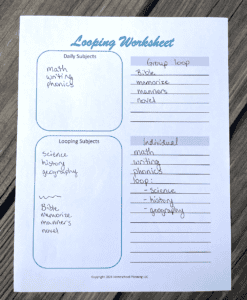
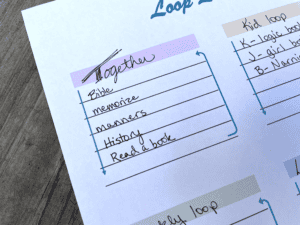

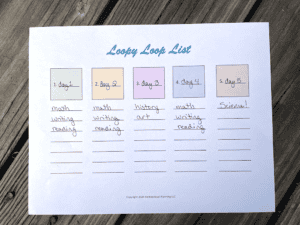
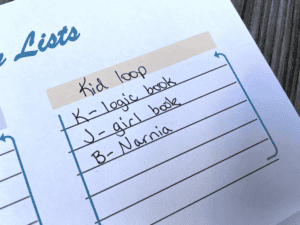
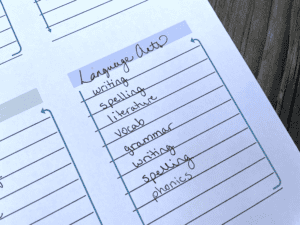

Homeschool loop schedule template
Want some simple worksheets to help you plan out your loops? I’ve got just the thing for you!
These simple worksheets will help you simplify your strict schedule without overcomplicating it. Add flexibility to your subjects, days, weeks, or anything else you want with these simple homeschool loop schedule printables!
Download your free homeschool loop schedule template now!

Homeschool loop schedule
A homeschool loop schedule can be such a handy, flexible, and simple tool to help you organize your homeschool schedule! From using a basic loop every day, to using a loop as part of a larger list, a loop to organize your whole week, or even using other looping techniques. You can take the stress off your shoulders of getting it all done and lean into the freedom a homeschool loop schedule can bring.
Related posts
7 Hacks for your Homeschool Schedule to save your Sanity
Why “Reverse Homeschool Planning” Isn’t What You Think it Is



